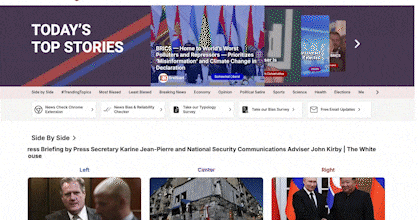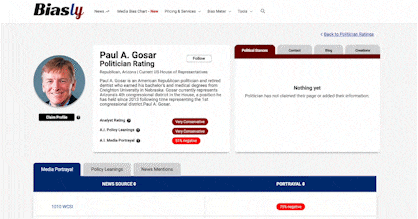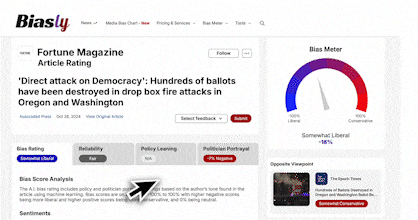
Since its establishment, the Daily Breeze has emerged as a vital source of news for the South Bay region of Los Angeles, serving its community with a blend of local insights and investigative reporting. Known for its commitment to journalistic excellence, the Daily Breeze provides coverage of everything from local politics to cultural events, reflecting the diverse interests of its readership. As a trusted platform in both digital and print formats, it plays a crucial role in keeping residents informed and engaged, fostering a well-informed community amid the evolving landscape of news media.
In this article, we will examine the Daily Breeze’s coverage and editorial choices to assess whether there is a noticeable political bias in their reporting. By analyzing their articles, opinion pieces, and overall narrative, we aim to provide a thorough understanding of the Daily Breeze’s stance and explore the elements that contribute to media bias within local journalism.
How Does Biasly Rate News Sources?
Biasly’s algorithms produce bias ratings to help provide multiple perspectives on given articles. Biasly has analyzed 200,000+ news articles from more than 3,200 news sources through our A.I. technology and team of political analysts to find the most factual, unbiased news stories.
Biasly determines the degree of political bias in news sources by using Biasly’s Bias Meter Rating, in which Biasly’s team analyzes media sources’ reliability and bias and produces three scores, a Reliability Score that measures the accuracy of media sources; an A.I. Bias Score, evaluated by A.I.; and an Analyst Bias Score evaluated by political analysts. These scores are rated based on seven rating metrics including Tone, Tendency, Diction, Author Check, Selection/Omission, Expediency Bias, and Accuracy. These metrics help our analysts to determine the political attitude of the article.
Our A.I. machine-learning system employs natural language processing and entity-specific sentiment analysis to examine individual articles and determine their bias levels. By analyzing the key terms in an article such as policies, bias phrases, political terminologies, politicians, and their nicknames, the algorithms can rate the attitude of the text. Bias scores range from -100% and 100%, with higher negative scores being more liberal and higher positive scores being more conservative, and 0% being neutral.
Is Daily Breeze Politically Biased?
Biasly’s rating for the Daily Breeze assigns the publication a Computer AI Bias Score of Center, derived from its AI-based algorithms. This analysis evaluates the authors’ tone, opinion, and diction, revealing their ideological tendencies.
For instance, Biasly’s analysis indicates that topics like criminal justice and election integrity are often framed with a conservative perspective, showing support for tougher law enforcement measures and skepticism toward voting processes. However, liberal viewpoints on issues like social welfare and environmental policy tend to be portrayed more favorably, often highlighting progressive solutions and the importance of government intervention. This balanced treatment of both conservative and liberal perspectives contributes to its Center rating, with the publication appearing to critique both sides depending on the topic, rather than consistently favoring one ideology over the other.
Alongside the Computer Bias Score, Biasly provides an Analyst Bias Score, developed through a review of at least 15 articles by a diverse team of analysts representing liberal, moderate, and conservative viewpoints. This score considers various types of bias in articles, preferences for certain politicians and policies, and overall narrative framing. The more articles the Biasly analyst team reviews, the more accurate the analyst score becomes, ensuring a comprehensive evaluation of the Daily Breeze’s ideological leanings.
Readers like you are likely to have a strong opinion of the Daily Breeze based on your political leaning because of their tendency to favor conservative causes and people as represented by Biasly’s “Center” rating. In the remainder of this article, we’ll talk about ways to identify this bias so you can separate the opinions from the facts and become a more informed consumer of news.
Before we begin, we need to discuss bias. Bias is a natural function of humans, and we can express it both consciously and unconsciously. Bias is one of the most fundamental forms of pattern recognition in humans. This isn’t to lower the bar and say that “all things are biased,” but to explain the process in which we may come to trust certain news organizations that display patterns of coverage.
On the media’s part, there is an incentive to retain audiences, encourage them to purchase subscriptions, and rate products positively. Bias is a two-way street, people want to see news stories about things they care about, and the media needs viewers to continue their operations. This creates a positive feedback loop that influences what stories are covered and from what perspective. This also explains the actions of more liberal news organizations.
Analysis of Bias in Daily Breeze Online Articles
When determining bias, some of the most common metrics used include Tone, Tendency, Author, Diction, and Expediency Bias, which are the primary metrics we’ll focus on below.
- Tone: This represents the attitude of the writing, formed distinctively but related to the author’s word choices or diction.
- Diction: The specific words chosen by the writer.
- Author: A metric related to the article’s author, taking into account their history of stance on issues based on past articles and social media posts.
- Tendency measures how consistently an author shows bias in their work, including factors like their tone and perspective.
- Expediency Bias relates to the immediate impression created by elements like the article’s headline, images, or summary, indicating if they favor a particular viewpoint.
The article we’ll examine is entitled “Trump and Biden both want to punish Julian Assange for exposing U.S. war crimes“. Biasly has rated this article as “Extremely Conservative”. The strong bias is evident as the author adopts a critical stance towards both the Trump and Biden administrations, framing their actions against Assange as a significant threat to press freedom and a continuation of government overreach.
The tone is established early in the piece, with phrases like “one of the greatest threats to freedom of the press” immediately signaling the author’s perspective. This language sets the stage for a narrative that positions Assange as a martyr for journalism, emphasizing the broader implications of his prosecution for investigative reporting.
When speaking of Julian Assange being granted asylum, the author remarks:
“In August 2012, Assange was granted asylum in the Ecuadorian embassy in London based on his fears of political persecution. … Eventually he was charged with 16 counts under the Espionage Act of 1917 and one count of computer hacking.”
Here, a strong diction throughout the article is carefully chosen to evoke a sense of urgency and injustice, using terms such as “punish,” “political persecution,” and “espionage.” By highlighting the chilling effect this case may have on press freedoms, the author seeks to galvanize readers’ concerns over government actions that undermine democratic principles.
In addition to the above example, the article also includes other word choices that demonstrate its strong conservative libertarian-leaning of language:
“It is shameful that the Biden administration has fully embraced Trump’s prosecution of Assange and is actively seeking to extradite him to the United States.”
“Using the Espionage Act to prohibit journalists from relying on such leaks would deprive the public of important news reporting.”
“Publishing information that exposes government wrongdoing is what the First Amendment is all about.”
These sentences reflect a strong critique of current and past U.S. administrations and emphasize a commitment to press freedom and government transparency, which are often highlighted in conservative critiques of government overreach.
Badges worn by a demonstrator outside Westminster Magistrates Court in London, Wednesday, Feb. 19, 2020. (AP Photo/Kirsty Wigglesworth)

Source: Daily Breeze
The badges displayed by a demonstrator in the image, notably featuring slogans like “Free Assange” and “No U.S. Extradition,” while supporting WikiLeaks, can relate to a conservative tone in certain contexts. These badges reflect a push against governmental authority, particularly U.S. government actions perceived as overreaching, which aligns with conservative values of limiting government power and protecting individual rights. The emphasis on opposing extradition to the U.S. resonates with conservative skepticism of international intervention and a preference for national sovereignty and due process.
While the article references multiple perspectives, it predominantly focuses on critiques of the U.S. government’s stance, largely omitting viewpoints that might support the legal actions against Assange. This selective representation suggests an omission bias, as arguments in favor of national security and the legality of prosecuting leaks are not adequately addressed.
In summary, although the author attempts to convey factual information about Assange’s case, the framing heavily leans towards a conservative critique of both political parties’ decisions. This article illustrates the need to critically assess bias through factors like tone, diction, and the representation of competing viewpoints, reinforcing the importance of vigilance in safeguarding press freedoms.
Analysis of The Daily Breeze Opinion Articles
Before we answer this question, we need to draw the distinction between opinion and reporting. While reporting is intended to be neutral, giving the reader the facts and quotes from primary sources to let them form their own opinion, opinions are an outlet for columnists to express their personal views on the issues of the day. While we saw elements of factual reporting in the analysis above, the Daily Breeze opinion pieces don’t seek objectivity but prioritize putting forth an opinion instead.
The first article we’ll examine is titled “Rate of young women getting sterilized doubled after Roe was overturned” carries an implied bias by highlighting a specific statistic that suggests a reactive trend to a controversial decision—overturning Roe v. Wade. This title might draw readers with an emotional response to the subject, aiming to emphasize the consequences of the judicial decision on personal health decisions.
Next, consider the opinion article “Appeals court judge rejects last-minute bid to halt Donald Trump’s hush money trial” appears more neutral and straightforward, primarily focusing on reporting a factual development in a legal case without overly charged language. It informs the reader of a specific legal decision without suggesting an opinion on the matter, thus leaning towards a less biased presentation compared to the first title.
These articles, in addition to those above, are not the bulk of the Daily Breeze content, but they indicate that the outlet is often characterized by a great deal of opinion — further underscoring the importance of knowing how to distinguish subjective writing from genuine reporting.
Who Owns Daily Breeze?
Druggist S.D. “Doc” Barkley launched the Daily Breeze in 1894 as a four-page weekly tabloid covering the community of Redondo Beach, California. Barkley’s newspaper venture began to grow more successful as the area began to develop.
How to Evaluate and Uncover Bias
It can often be difficult to tell if the news you watch is biased. If you have settled on a news channel, it’s usually because you trust the information you are gaining. Unfortunately, many trust the information they are hearing because it confirms what they already believe. This is referred to as “confirmation bias.” It is important to challenge your beliefs and get third-party verification that what you are hearing is the full story. This is why we recommend using Biasly to compare different news stories side-by-side using our bias ratings to figure out what both sides think of a political issue.
Even though Biasly gave Daily Breeze a Center bias score, remember that bias varies by article, and Daily Breeze does not exclusively publish liberal or conservative thought pieces. In fact, it is known to have produced some centrist and conservative-leaning articles before. Additionally, some article types will inherently have more or less bias; general news articles are known for being less biased than opinion pieces. And while every article you read will be biased to some degree, some stick to the facts better than others, which is why it’s so important to use Biasly’s News Check to help you determine the bias of what you read.

























